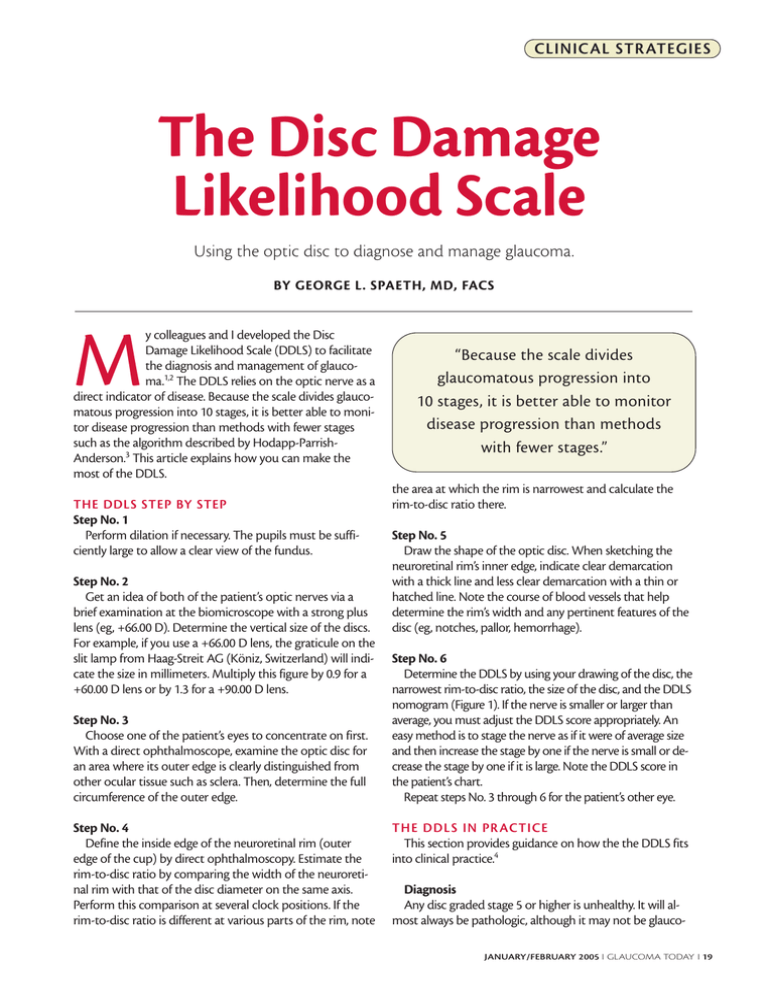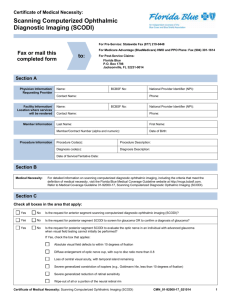VIEW PDF - Glaucoma Today
advertisement

CLINICAL STR ATEGIES The Disc Damage Likelihood Scale Using the optic disc to diagnose and manage glaucoma. BY GEORGE L. SPAETH, MD, FACS M y colleagues and I developed the Disc Damage Likelihood Scale (DDLS) to facilitate the diagnosis and management of glaucoma.1,2 The DDLS relies on the optic nerve as a direct indicator of disease. Because the scale divides glaucomatous progression into 10 stages, it is better able to monitor disease progression than methods with fewer stages such as the algorithm described by Hodapp-ParrishAnderson.3 This article explains how you can make the most of the DDLS. THE DDLS STEP BY STEP Step No. 1 Perform dilation if necessary. The pupils must be sufficiently large to allow a clear view of the fundus. Step No. 2 Get an idea of both of the patient’s optic nerves via a brief examination at the biomicroscope with a strong plus lens (eg, +66.00 D). Determine the vertical size of the discs. For example, if you use a +66.00 D lens, the graticule on the slit lamp from Haag-Streit AG (Köniz, Switzerland) will indicate the size in millimeters. Multiply this figure by 0.9 for a +60.00 D lens or by 1.3 for a +90.00 D lens. Step No. 3 Choose one of the patient’s eyes to concentrate on first. With a direct ophthalmoscope, examine the optic disc for an area where its outer edge is clearly distinguished from other ocular tissue such as sclera. Then, determine the full circumference of the outer edge. Step No. 4 Define the inside edge of the neuroretinal rim (outer edge of the cup) by direct ophthalmoscopy. Estimate the rim-to-disc ratio by comparing the width of the neuroretinal rim with that of the disc diameter on the same axis. Perform this comparison at several clock positions. If the rim-to-disc ratio is different at various parts of the rim, note “Because the scale divides glaucomatous progression into 10 stages, it is better able to monitor disease progression than methods with fewer stages.” the area at which the rim is narrowest and calculate the rim-to-disc ratio there. Step No. 5 Draw the shape of the optic disc. When sketching the neuroretinal rim’s inner edge, indicate clear demarcation with a thick line and less clear demarcation with a thin or hatched line. Note the course of blood vessels that help determine the rim’s width and any pertinent features of the disc (eg, notches, pallor, hemorrhage). Step No. 6 Determine the DDLS by using your drawing of the disc, the narrowest rim-to-disc ratio, the size of the disc, and the DDLS nomogram (Figure 1). If the nerve is smaller or larger than average, you must adjust the DDLS score appropriately. An easy method is to stage the nerve as if it were of average size and then increase the stage by one if the nerve is small or decrease the stage by one if it is large. Note the DDLS score in the patient’s chart. Repeat steps No. 3 through 6 for the patient’s other eye. THE DDLS IN PR ACTICE This section provides guidance on how the the DDLS fits into clinical practice.4 Diagnosis Any disc graded stage 5 or higher is unhealthy. It will almost always be pathologic, although it may not be glaucoJANUARY/FEBRUARY 2005 I GLAUCOMA TODAY I 19 CLINICAL STR ATEGIES Figure 1. The DDLS is based on the radial width of the neuroretinal rim measured at its narrowest point. Once there is an area of absent rim, the DDLS score is based on the circumferential extent of absent rim. The unit of measurement is the rim-to-disc ratio. When there is no rim remaining, the rim-to-disc ratio is zero. The circumferential extent of absent rim (zero rim-to-disc ratio) is measured in degrees. Caution must be taken to differentiate the actual absence of rim from sloping of the rim, which, for example, can occur temporally in some patients with myopia. Because the width of the rim is a function of disc size, the physician must evaluate the latter prior to attributing a DDLS stage. matous. Damage from glaucoma will usually be infero- or superotemporal. DDLS scores of 1 through 3 are rarely associated with glaucomatous visual field loss. Some individuals are born with DDLS 3 optic discs, whereas others begin with DDLS 1 discs. For this reason, noting that a person has a DDLS 3 optic disc indicates that it is reasonably healthy and that there is no visual field loss. This score is not proof that the disc’s health has not worsened, however, because it could have been a stage 1 or 2 in the past. Categorization The DDLS allows you to quantify the amount of damage that the optic nerve has sustained. Visual field loss usually will not occur before stage 5. The differentiation between very early and no damage is important, because a neuroretinal rim that has already narrowed is likely to become narrower still, whereas an undam20 I GLAUCOMA TODAY I JANUARY/FEBRUARY 2005 aged rim is far more likely to remain stable. You may choose to defer treatment and observe closely patients with optic nerves of stages 0 through 5, because the consequences of treatment may outweigh those of nontreatment. Unless glaucomatous progression has stabilized (eg, in cases of inactive glaucoma secondary to trauma or corticosteroids), a DDLS score of 6 through 10 strongly supports aggressive treatment. Monitoring The stability of a patient’s glaucoma is often best determined by evaluating the optic disc. I note the DDLS scores on patients’ charts every time I examine the fundus, meaning at every visit when I am assessing whether their glaucoma is stable, improving, or deteriorating. The only time that I do not examine the fundus and use the DDLS is at a visit when I am judging an intervention’s effect on IOP (eg, a follow-up visit 3 weeks after the patient began using glaucoma drops). CONCLUSION I think there are two reasons that we physicians have not used the optic disc as a method for following patients. First, because the disc is difficult to examine, we must perform the analysis ourselves, whereas visual field testing may be delegated to a technician. Visual field examinations—especially when performed by current, automated perimeters—provide information that seems hard and is often presented as a meaningful number, such as a specific mean defect. It is tempting to conclude that a worsening of one of these measures (eg, a change from a mean defect of 17.3 to 19.2) represents a real deterioration. Unfortunately, these measures are often misleading because of the large amount of noise and the variability in visual field testing. Second, in the past, there was no valid way of quantifying changes to the optic disc. Now, when a patient’s DDLS score is 6 when, 4 years earlier, it was 3, we know that the glaucoma is progressing and can calculate its rate of change. ❏ George L. Spaeth, MD, FACS, is Director of the William and Anna Goldberg Glaucoma Service and Research Laboratories at Wills Eye Hospital, and he is Professor of Ophthalmology at Jefferson Medical College in Philadelphia. He stated that he holds no financial interest in the DDLS, the products, or the company mentioned herein. Dr. Spaeth may be reached at (215) 928-3960; gspaeth@willseye.org. 1. Bayer A, Harasymowycz P, Henderer JD, et al. Validity of a new disk grading scale for estimating glaucomatous damage: correlation with visual field damage. Am J Ophthalmol. 2002;133:758-763. 2. Henderer JD, Liu C, Kesen M, et al. Reliability of the Disc Damage Likelihood Scale (DDLS): a comparison to an existing alternative scale. Am J Ophthalmol. 2003;135:44-48. 3. Hodapp E, Parrish II R, Anderson D. Clinical Decisions in Glaucoma. St. Louis: Mosby-Year Book, Inc.; 1993. 4. Spaeth GL, Henderer J, Steinmann W. The Disc Damage Likelihood Scale (DDLS): its use in the diagnosis and management of glaucoma. Highlights of Ophthalmology. 2003;31:4-19.


